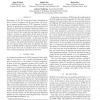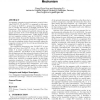SIGMETRICS
2011
ACM
13 years 6 months ago
2011
ACM
Many network links in developing regions operate in the subpacket regime, an environment where the typical per-flow throughput is less than 1 packet per round-trip time. TCP and ...
CN
2011
13 years 6 months ago
2011
Standard slow start does not work well under large bandwidthdelay product (BDP) networks. We find two causes of this problem in existing three popular operating systems, Linux, F...
WINET
2002
14 years 2 months ago
2002
Abstract. TCP Westwood (TCPW) is a sender-side modification of the TCP congestion window algorithm that improves upon the performance of TCP Reno in wired as well as wireless netwo...
COMCOM
2004
14 years 3 months ago
2004
Bandwidth-delay product (BDP) and its upper bound (BDP-UB) have been well-understood in wireline networks such as the Internet. However, they have not been carefully studied in th...
COMCOM
2008
14 years 3 months ago
2008
Performance of the TCP Congestion Control Algorithm has been the focus of research over the last decade. In this paper we propose modifications to TCP Congestion Control to improv...
CCR
2008
14 years 3 months ago
2008
An aggregate congestion control mechanism, namely ProbeAided MulTCP (PA-MulTCP), is proposed in this paper. It is based on MulTCP, a proposal for enabling an aggregate to emulate ...
ICNP
1997
IEEE
14 years 7 months ago
1997
IEEE
TCP's ability to share a bottleneck fairly and efficiently decreases as the number of competing flows increases. This effect starts to appear when there are more flows than p...
ICCCN
1998
IEEE
14 years 7 months ago
1998
IEEE
TCP is a popular transport protocol used in present-day internet. When packet losses occur, TCP assumes that the packet losses are due to congestion, and responds by reducing its ...
INFOCOM
2000
IEEE
14 years 7 months ago
2000
IEEE
Abstract—In this paper we propose a modification of the Explicit Congestion Notification (ECN) [1] to correct the bias against connections with long round trip times (RTT) of T...
INFOCOM
2003
IEEE
14 years 8 months ago
2003
IEEE
— In this paper, we present an analytical TCP model that takes into account of several issues that were ignored in the other existing models (such as those in [15], [19]), i.e., ...






